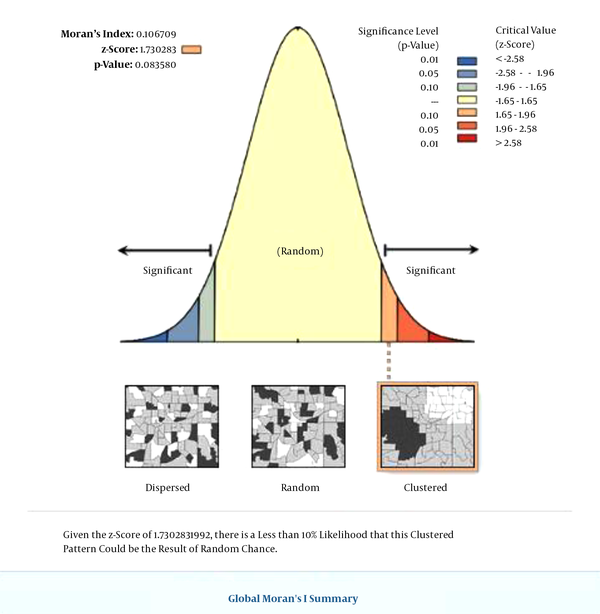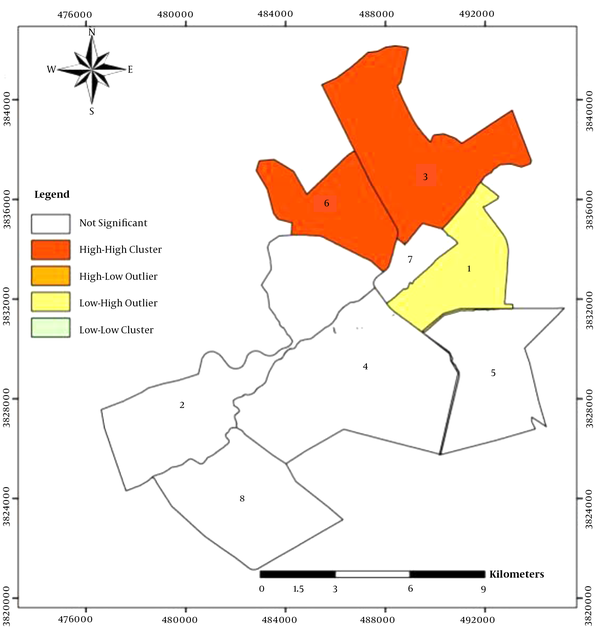Dear Editor,
In late 2019, a novel virus called severe acute respiratory syndrome coronavirus 2 (SARS-CoV-2) was identified in Wuhan, Hubei Province, China, which was reported to be the cause of cases of pneumonia. The disease spread rapidly, and after the epidemic in China, its cases increased throughout the world (1). In recent years, the use of GIS has increased significantly in order to determine the geographical distribution patterns of diseases in medical and health sciences (2-4). In order to determine the spatial patterns of diseases, the local indicators of spatial association (LISA) in environmental GIS are substantially helpful. This model includes a set of methods to describe and visualize spatial distribution, identify atypical locations or spatial outliers, determine the patterns of spatial associations, clusters, or hot-spots, and finally propose spatial regimes or other types of spatial heterogeneity (5). Due to the spread of COVID-19 in many countries worldwide, including Iran, and particularly Qom Province as the origin of the disease in the country, there is a need to control and prevent disease propagation as much as possible by determining the spatial pattern and geographical distribution of the disease in different districts and areas of Qom Province to identify its high-risk areas. Subsequently, controlling and preventive measures can be carried out more purposefully. Therefore, this study was designed to analyze the spatial distribution pattern of COVID-19 in central Iran using the LISA model. Geographical analyses to identify the geographical factors affecting the spread of the COVID-19 infection can help modify public health policies to constrain the virus. The aim of this study was to conduct a spatial analysis on COVID-19 affected regions in Qom Province using the LISA model. In a descriptive-analytical study, all the individuals infected with COVID-19 in Qom Province from February 19 to September 2020 were included in the study. The spatial distribution in urban areas was determined using the Moran coefficient in GIS. In addition, the spatial autocorrelation of the coronavirus was calculated in different urban districts of the province using the LISA method. The prevalence of COVID-19 in Qom Province was estimated to be 356.75 per 100,000 population. The spatial distribution maps of the COVID-19 disease in Qom Province showed that most cases (97%) of the disease occurred in the Markazi District and in the city of Qom, and a few cases (3%) had been reported from rural districts. The prevalence of COVID-19 in urban districts was 350.49 per 100,000 people, and in the rural areas of Qom Province, it was estimated at 4.51 per 100,000 population. Regarding the prevalence of this disease in urban areas, the District 7 (Holy shrine), District 4 (Zanbilabad-Salarieh), and District 6 (Imamzadeh Ebrahim Street) had the highest incidence rates of the disease in Qom City (Table 1).
Prevalence of COVID-19 Infection in Urban Areas of Qom Province, Central Iran, from February 19, 2020, to September 2020
| Urban Districts | Population | Cases | Incidence/100,000 |
|---|---|---|---|
| 1 | 78401 | 243 | 309.94 |
| 2 | 192060 | 671 | 349.37 |
| 3 | 189708 | 642 | 338.41 |
| 4 | 171363 | 808 | 471.51 |
| 5 | 192755 | 642 | 333.06 |
| 6 | 213356 | 930 | 435.89 |
| 7 | 41625 | 227 | 545.34 |
| 8 | 121890 | 225 | 184.59 |
With the spread of the novel coronavirus in Qom Province since February 19, 2020, in order to conduct the point pattern analysis of COVID-19 in the province, Moran's Index was calculated (Moran's Index: 0.106709, Z-score: 1.730283, and p-value: 0.083580 with 90% confidence interval). Accordingly, the spatial distribution pattern of the COVID-19 disease in Qom Province was drawn (Figure 1), which indicated that the highest prevalence of the disease was related to the urban districts of seven, four, and six, respectively (Table 1). Based on this analysis on the incidence of the COVID-19 infection, District 3 (Imam Khomeini St.) and District 6 (Imamzadeh Ebrahim St.), as two urban districts in the Province, were placed in the HH category of the LISA model, highlighting them as two foci of COVID-19 in Qom Province (Figure 2). This means that the incidence of the disease in these two districts is higher (above average), and at the same time, the two districts are also surrounded by areas with a high incidence of COVID-19 (i.e., high-value areas). Also, autocorrelation in these two urban districts was positive and included more than one-third of the population of Qom (33.55%). In addition, based on the LISA model, District 1 (Bajak), an urban region, was placed in the LH category, meaning that it was a low-value area surrounded by high-value regions (Figure 2). One of the most important geographical factors affecting the incidence of the coronavirus infection based on the spatial distribution model was distance or spatial proximity. So, health policymakers should impose more restrictions to ensure the observance of health protocols by people to contain the coronavirus.
The point pattern analysis of COVID-19 in Qom Province from February 19, 2020, to September 2020.

The spatial autocorrelation of the novel coronavirus using the local indicators of spatial association (LISA) in the urban districts of Qom City from February 19, 2020, to September 2020.

References
-
1.
Chen N, Zhou M, Dong X, Qu J, Gong F, Han Y, et al. Epidemiological and clinical characteristics of 99 cases of 2019 novel coronavirus pneumonia in Wuhan, China: a descriptive study. Lancet. 2020;395(10223):507-13. [PubMed ID: 32007143]. [PubMed Central ID: PMC7135076]. https://doi.org/10.1016/S0140-6736(20)30211-7.
-
2.
Salimi M, Jesri N, Javanbakht M, Farahani LZ, Shirzadi MR, Saghafipour A. Spatio-temporal distribution analysis of zoonotic cutaneous leishmaniasis in Qom Province, Iran. J Parasit Dis. 2018;42(4):570-6. [PubMed ID: 30538355]. [PubMed Central ID: PMC6261142]. https://doi.org/10.1007/s12639-018-1036-5.
-
3.
Mohammadbeigi A, Saghafipour A, Jesri N, Tarkhan FZ, Jooshin MK. Spatial distribution of vaccine-preventable diseases in central Iran in 2015-2018: A GIS-based study. Heliyon. 2020;6(9). e05102. [PubMed ID: 33024873]. [PubMed Central ID: PMC7527658]. https://doi.org/10.1016/j.heliyon.2020.e05102.
-
4.
Akbarzadeh K, Saghafipour A, Jesri N, Karami-Jooshin M, Arzamani K, Hazratian T, et al. Spatial Distribution of Necrophagous Flies of Infraorder Muscomorpha in Iran Using Geographical Information System. J Med Entomol. 2018;55(5):1071-85. [PubMed ID: 29982597]. https://doi.org/10.1093/jme/tjy098.
-
5.
Anselin L. Exploratory spatial data analysis in a geocomputational environment. Geocomputation: A Primer. Chichester New York: Wiley; 1998.